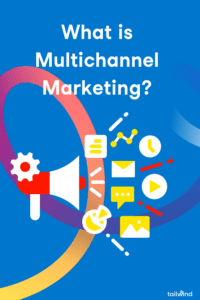
In today’s digital-dominated landscape, multichannel marketing isn’t just a buzzword — it’s a fundamental approach that amplifies a brand’s voice amidst the buzz of the market chatter.
But what is it, and how can it benefit your business? This is exactly what we will focus on today.
Multichannel Marketing Definition
Multichannel marketing refers to the practice of engaging customers and prospects through various communication channels to maximize marketing outreach and effectiveness.
It is a strategic approach implemented by businesses to interact with their target audience using different platforms, both online and offline.
In the digital age, multichannel marketing has become crucial for businesses to stay competitive and increase (or just maintain) their brand visibility.
Some common marketing channels include:
- Email marketing
- Social media marketing
- Content marketing
- SMS marketing
- Direct mail
- Webinars
- Performance (or PPC) marketing
In 2023, digital marketing channels such as social media, email, and content marketing play a significant role in multichannel marketing strategies.
With the continuous growth of digital platforms, businesses are adapting to consumers’ changing behaviors and preferences to create and maintain a strong online presence.
Evolution of Marketing Channels
The evolution of marketing channels can be traced back to the early days of traditional marketing practices such as print advertising and direct mail.
With the advent of the internet and digital technology, new marketing channels emerged, including search engine marketing, email marketing, and social media marketing.
The timeline of marketing channel evolution can be summarized as follows:
| Time Period | Marketing Channels |
| Pre-digital era | Print advertising, radio ads, billboards, direct mail |
| 1990s – early 2000s | Search engine marketing, email marketing |
| Mid 2000s – present day | Social media marketing, content marketing, mobile marketing |
As marketing channels continue to evolve, modern businesses adapt to the latest trends in digital marketing and carefully curate their messaging to achieve maximum impact.
Multichannel marketing strategies allow businesses to reach a wider audience through well-coordinated campaigns across different platforms, ultimately driving customer engagement and increasing revenue.
Importance of Multichannel Marketing
Meeting Consumer Expectations
In today’s fast-paced world, customers expect a seamless and consistent experience across multiple channels.
Multichannel marketing helps businesses meet this demand by providing a cohesive brand experience across various platforms such as social media, email, mobile, and in-store (if applicable).
This approach allows customers to engage with a brand on their preferred channel, increasing overall satisfaction.
Enhancing Brand Visibility
Multichannel marketing helps enhance brand visibility by reaching out to a wider audience through multiple platforms.
It means more touchpoints for consumers to interact with the business, leading to increased brand awareness.
By using a combination of different marketing channels, companies can ensure a stronger presence in the market and leverage both online and offline mediums to their advantage.
| Marketing Channel | Brand Visibility Benefit |
| Social Media | Engage customers, increase followers |
| Personalized communication, targeted promotions | |
| Mobile | Instant notifications, location-based services |
Improved Return on Investment (ROI)
One of the main benefits of multichannel marketing is the improved return on investment. By adopting a comprehensive approach, businesses can not only increase their reach and visibility but also better target their marketing efforts.
This can result in higher conversion rates (due to multiple touch-points), more efficient spending, and ultimately higher ROI.
The ability to track and measure the performance of multiple channels enables businesses to optimize their marketing strategies and allocate resources more effectively.
- Experience: Multichannel marketing helps create a cohesive and enjoyable experience for customers, leading to increased satisfaction and loyalty.
- Brand awareness: By establishing a presence across multiple channels, businesses can reinforce their brand identity and foster customer recognition.
- Return on investment: By analyzing the performance of each channel, companies can refine their marketing strategies, maximize impact, and improve their overall return on investment.
- Visibility: A multichannel approach ensures companies have a strong presence in the market, increasing their reach and influence.
Key Components of Multichannel Marketing
Different Marketing Channels
Multichannel marketing involves utilizing various channels — both online and offline — to reach and engage with target audiences. These channels include:
- Digital marketing: Email, social media, SEO, and mobile marketing (through SMS and apps)
- Offline marketing: TV, print, radio, and direct mail
It is crucial for businesses to choose the right combination of channels to optimize their marketing strategy.
Customer Segmentation
To effectively target customers, it’s essential to segment them into groups based on shared characteristics.
This process allows businesses to tailor their marketing messages and strategies to resonate with specific customer segments, resulting in more effective campaigns.
Some segmentation methods include:
- Demographics: Age, gender, income, education, and occupation
- Behaviors: Online browsing habits, purchasing history, and product preferences
- Interests: Hobbies, activities, and lifestyle choices
Integrated Marketing Communication (IMC)
Integrated Marketing Communication (IMC) ensures that the different marketing channels work together seamlessly and consistently to deliver a unified message to the target audience.
This requires coordinating various components — such as the content, timing, and presentation — across all chosen channels to create a cohesive strategy. Key aspects to consider in an IMC approach include:
- Content: Ensure the message is consistent across all channels, yet tailored to the specific platform (e.g., email, social media, SMS)
- Timing: Schedule campaigns to reach audiences at the optimal times
- Analytics: Leverage data to track performance and inform future strategies
Successful implementation of IMC involves closely monitoring, measuring, and adjusting the marketing strategy based on insights from analytics and attribution models.
Additionally, inbound marketing tactics such as content marketing and SEO should be integrated with other channels like social media marketing or email marketing (with email capture) to make sure you are maximizing your potential.
Benefits of Multichannel Marketing
Broader Reach
Multichannel marketing allows businesses to reach a wider audience because it involves using various advertising platforms.
For example, by having both online and offline presence, businesses can tap into different customer segments, increasing brand awareness and boosting consumer engagement.
Some key advantages include:
- Expansion of the brand’s network
- Diversification of marketing efforts
- Attraction of customers through various touchpoints
It goes without saying that diversification applies to digital channels as well. Mostly, businesses are focused on 1-2 main channels, ignoring the potential that others might hold.
Rigorous testing and continuous improvement may change that!
Customer Preference and Convenience
By catering to different preferences, businesses can improve the customer experience and build brand loyalty. Examples of ways to provide this personalized experience include:
- In-store promotions
- Online advertisements
- Social media engagement
- Direct email marketing
The main point is, the more times the customer sees you, the more likely they are to use your service.
In some cases, it takes 5-7 touch points before the customer makes a decision. So instead of the prospect seeing your ad once, the goal here is to make them see the ad, then see a blog post, then see a social post, then see your page. By the time they actually land on your sales page, they already know what your company stands for and are ready to make a decision.
Increased Sales Opportunities
Multichannel marketing increases the chances of potential customers encountering a brand, which can ultimately lead to more sales.
With multiple channels, businesses can target their buyer personas more effectively, increasing the probability of converting prospects, such as:
- Offering personalized product recommendations
- Communicating promotions and discounts across channels
- Retargeting potential buyers who have visited the online store
Data-Driven Insights
Implementing a multichannel marketing strategy provides businesses with valuable insights into consumer behavior and preferences.
By tracking different channels, businesses can collect data that helps improve their marketing strategies. Some potential benefits of these data-driven insights include:
- Understanding the most effective advertising channels
- Identifying patterns and trends in consumer behavior
- Optimizing marketing strategies based on data analysis
Marketing attribution is quite a challenge. Particularly when you are running a multichannel marketing strategy.
Did the client decide based on the ad they’ve seen? Or because they participated in your webinar two months ago?
The takeaway should be that you should take all the data that you receive with a grain of salt, as they give you an indication rather than 100% bulletproof information.
One way to solve this is to have self-attribution in your registration forms. Sure, it makes the signup process a bit more difficult for the client, but it might give you the right insight to make sure that you are focusing on the most efficient channels.
Challenges in Multichannel Marketing
Channel Consistency and Branding
One challenge in multichannel marketing is maintaining channel consistency in terms of messaging and branding.
Each channel, such as the website, social media platforms, and ads, should have a coherent and consistent message that resonates with the customers:
- A consistent tone of voice and visual style should be used
- The customer journey should flow seamlessly across channels
- Adapting messages for different platforms without losing overall consistency
Achieving this coherence ensures a better brand experience, strengthens brand identity, and increases the chances of conversion.
PRO TIP
Maintain an easily accessible file with your brand colors and fonts. Expand the colors to include a “bright” or “pastel” palette, but don’t deviate from the colors you’ve chosen.
Make sure someone on your team reviews designs for brand consistency before they are published.
You can plan your marketing in the same way that you plan your development — in cycles or in sprints.
For example, you will decide that for the next two weeks you will be running only things related to Black Friday. In that case, make sure that all your digital assets are aligned and are carrying the same message/offer.
Data Silos and Integration
In multichannel marketing, data is often collected from various sources, including direct and indirect channels.
However, it can be challenging to effectively integrate and manage customer data, resulting in data silos. Some common issues might occur:
- Difficulty in capturing, integrating, and accessing data from different channels
- Fragmented or duplicated customer records and information
- Difficulty in identifying cross-channel customer interactions
To overcome these obstacles, you will need to invest in advanced analytics tools, customer data platforms, and data integration systems to create a unified view of their customer journey and communication.
Additionally, pick your internal source-of-truth: a platform where all the data will be combined and will serve as the main information hub for your whole team.
Measuring Performance Across Channels
While individual channel analytics might provide insights, it is essential to evaluate the overall performance of a multichannel campaign. Factors to consider are:
- Conversion rates for individual channels
- Interaction and engagement rates per channel
- Attribution of sales and revenue to respective channels
By using advanced analytics tools, marketers can gain insights into campaign performance, customer behavior, and determine their most effective channels, thus optimizing their marketing strategies.
PRO TIP
Maintaining a multichannel changelog can be very helpful. Note the date, channel and details about any change. Then, if your overall performance metrics change, you will be able to identify what channel changes may have contributed.
Resource Allocation and Management
Efficiently allocating and managing resources for multichannel marketing campaigns can be challenging. Some organizations might struggle with:
- Balancing between direct and indirect channels
- Prioritizing budget allocation for various channels
- Ensuring consistent communication and collaboration between teams
Identifying and tackling these challenges requires a data-driven approach, robust management systems, and efficient resource allocation tools to ensure that multichannel marketing campaigns generate maximum ROI.
Best Practices in Multichannel Marketing
Understanding Your Audience
To create an effective multichannel marketing plan, it’s crucial to understand your audience. This can be achieved through in-depth analysis of customer demographic information, preferences, and purchasing behavior.
Profiling your audience allows you to tailor content and campaigns specifically for different segments, resulting in a better connection and increased attraction.
Ensuring Channel Cohesiveness
It’s essential to ensure cohesiveness across all channels — whether it’s a blog, social media platform, or outbound marketing tactic.
Creating a consistent brand presence helps to build trust with prospects and customers. To achieve this, ensure that all team members involved in the marketing process are on the same page about your brand’s messaging, tone, and objectives.
PRO TIP
Not sure what your brand tone is? Upload a blog post that represents you well to Chat GPT and ask the AI to analyze it for voice, tone, and style.
Using Technology and Tools
Leveraging technology and tools in your multichannel marketing strategy helps save time and streamline the campaign management process.
Opt for a comprehensive platform that brings together different channels and marketing mix elements in a central location. Important features include:
- Campaign planning and execution
- Content organization and management
- Performance tracking and analytics
By using the right tools, marketers can increase efficiency and maximize campaign results.
Continuous Testing and Optimization
The key to success in multichannel marketing is continuous testing and optimization. As audience preferences and platform features evolve over time, it’s crucial to set milestones for periodically revising your marketing plan. Consider the following steps for ongoing improvement:
- Analyze performance data for each channel
- Identify areas for improvement
- Test alternate marketing tactics
- Make necessary adjustments to campaigns
- Monitor results and continue to optimize
Following these best practices in multichannel marketing will ensure that your campaigns are coordinated, optimized, and tailored to meet the needs and preferences of your target audience.
The Future of Multichannel Marketing
The Rise of Omnichannel Marketing
Omnichannel marketing is an evolution of multichannel marketing, offering a seamless and unified customer experience.
Instead of simply having multiple channels for customers to engage with a brand, the focus is on integrating these channels for optimal results.
This approach aims to better understand customer behaviors and improve marketing efforts.
The future of multichannel marketing will require businesses to leverage emerging channels and adopt omnichannel strategies to create cohesive cross-channel campaigns.
Technological Innovations and Integrations
Future multichannel marketing strategies will increasingly rely on technological advances and integrations.
Marketing automation will play a crucial role in the efficient management of potential customers across different channels. Integration of various tools, platforms, and systems will enable comprehensive and data-driven marketing attribution analysis.
Some things to expect include:
- AI-powered analytics: Utilizing artificial intelligence to better understand customer behaviors and preferences across multiple channels.
- Emerging channels: The incorporation of new channels like virtual reality, chatbots, and voice-activated devices to enhance the customer experience.
- Interactive content: The creation of interactive and immersive content to increase engagement across all channels.
The Role of Personalization and Automation
Personalization and automation are significant factors in the future of multichannel marketing. Businesses will need to:
- Utilize customer insights to deliver tailored content and experiences across all marketing channels.
- Implement automated systems to manage cross-channel campaigns more effectively and reduce manual labor.
- Adapt to changing customer behaviors and preferences using real-time data.
Action Steps
In order to implement a successful multichannel marketing strategy, consider the following action steps:
- Establish clear goals: Before embarking on a multichannel marketing approach, it is crucial to define your objectives. Goals can include increasing conversion rates, boosting customer engagement, or enhancing brand awareness. Determining your goals will provide direction and focus for your multichannel efforts.
- Understand the role of attribution: Attribution is the process of identifying which marketing channels contribute to conversions, essentially assigning value to each channel involved in the customer journey. Establishing a robust attribution model will provide insight into how different channels are performing and where to allocate resources for optimal outcomes.
- Leverage physical/digital storefronts: Incorporate offline and online locations in your multichannel marketing strategy when possible. Utilize in-store promotions, partnerships, and events to connect with customers, enhance their experience, and increase conversions both online and offline.
- Employ predictive analytics: Predictive analytics tools can analyze historical data and identify trends to forecast future customer behavior. Use these insights to create proactive marketing strategies such as adjusting promotional offers, segmenting target audiences, and optimizing channel performance.
- Deliver a personalized experience: Today’s customers expect a tailored experience across all channels. Implement personalization tactics such as using customer data to inform content and promotional offers, and to strengthen customer relationships and increase engagement.
By considering these action steps and integrating them into your multichannel marketing approach, you can create a comprehensive and effective strategy that drives results and enhances customer experiences.







